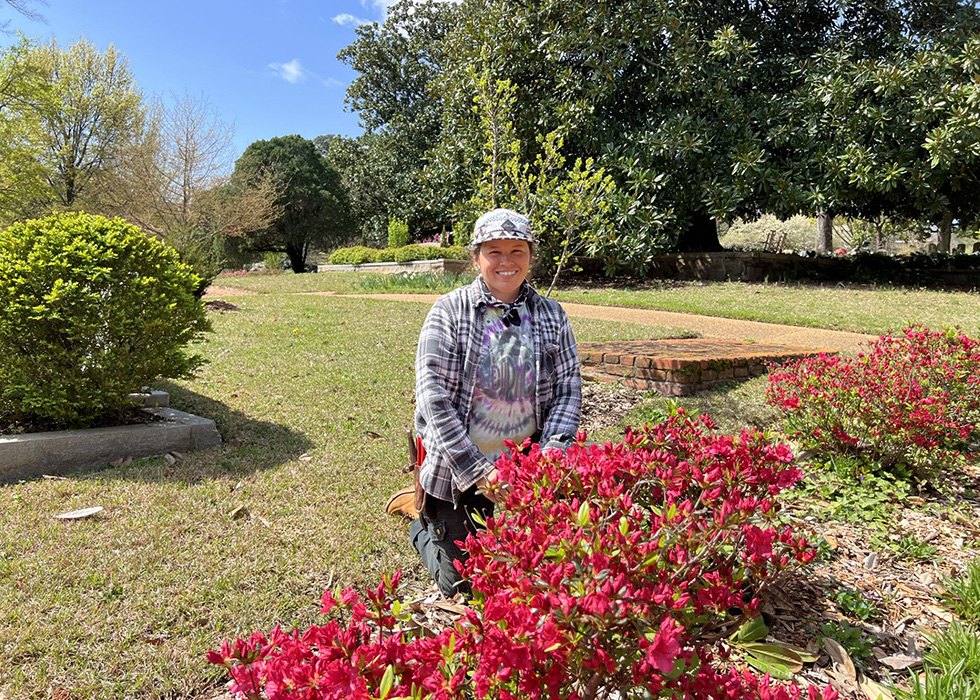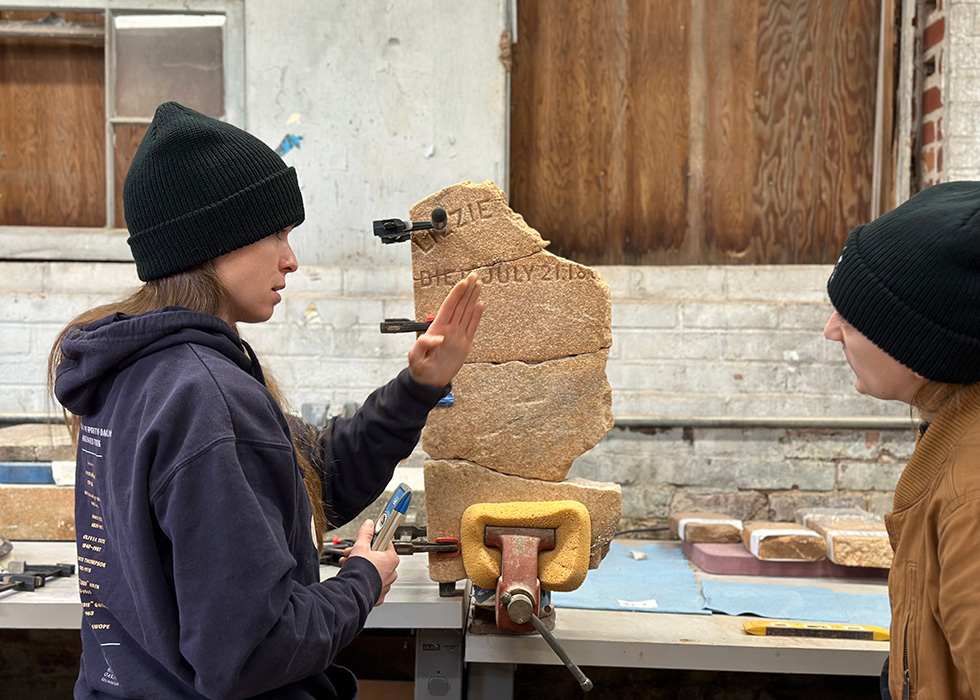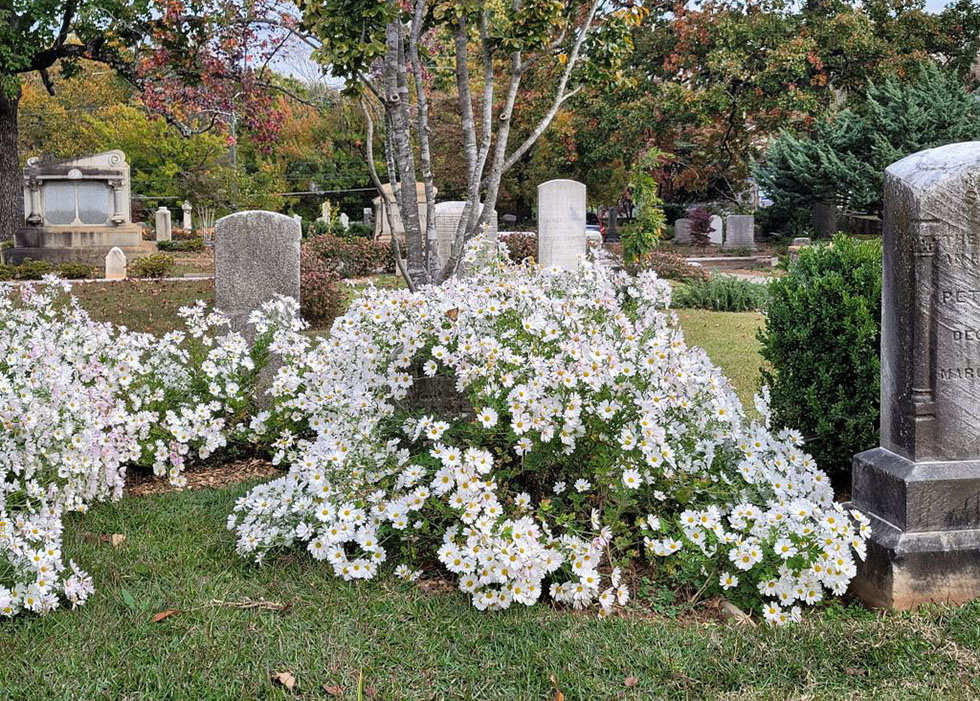
Oakland’s Early Landscapes: Wood Enclosures and Wrought Iron Fencing
 From Oakland’s earliest decades, families have desired to enclose their loved ones’ last resting place as their financial means would allow. For some that meant wood, for others granite and iron were within reach. For less affluent families a row of bricks, or later, a simple line of concrete on a narrow metal support frame was all they could afford to claim their hallowed ground.
From Oakland’s earliest decades, families have desired to enclose their loved ones’ last resting place as their financial means would allow. For some that meant wood, for others granite and iron were within reach. For less affluent families a row of bricks, or later, a simple line of concrete on a narrow metal support frame was all they could afford to claim their hallowed ground.

 Much of Oakland’s appearance in its first two decades remains obscure. In the years before and during the war, record keeping and newspaper articles are sparse, and no one took photographs of the City Grave Yard. In 1857 the first ordinance issued by the City Council regarding the City Cemetery addressed its protection. The ordinance specifically covered any “fence, railing or other work for the protection or ornament of any tomb monument gravestone or other structure.…” Inferring from later cemetery reports and newspaper articles, it seems fences were constructed of wood and metal wire, and “railing” was a granite plinth and iron pole design.
Much of Oakland’s appearance in its first two decades remains obscure. In the years before and during the war, record keeping and newspaper articles are sparse, and no one took photographs of the City Grave Yard. In 1857 the first ordinance issued by the City Council regarding the City Cemetery addressed its protection. The ordinance specifically covered any “fence, railing or other work for the protection or ornament of any tomb monument gravestone or other structure.…” Inferring from later cemetery reports and newspaper articles, it seems fences were constructed of wood and metal wire, and “railing” was a granite plinth and iron pole design.
Wooden fencing seems to have been erected only in the Original Six Acres and then mostly prior to the Civil War. Union troops were not kind to Atlanta’s cemetery, as the burning of the main fence and palings (open wood fencing) around the graves was reported, among other trespasses. Amazingly one stereoview dating to the mid-1870s did capture a wood fence around a small lot near the Austell mausoleum. Of moderate height and of solid plank construction (not open palings), the support posts have large balls for decorative finials. One might presume it was a new fence, perchance to replace one lost during the Federals’ occupation. However none of the other early images of areas outside the Original Six Acres hint at wood fencing. By 1875 an improvement on the standard wood fence advertised in The Constitution offered wrought iron panels (shipped from elsewhere) mounted to wood posts.

In 1876 the Annual Report to the City Council detailed how the “old cemetery” was cleared of tumbled down brick vaults and rotted wood enclosures, at no expense to the lot owners. One gets the sense that the sextons had no interest in the old wood fencing tradition – so prone to deterioration – marring Oakland’s new landscape aesthetic. By the spring of 1878 an article in The Constitution reported with approval, “The owners of the lots in all parts of the cemetery seem to feel a just pride in their neat appearance. New iron railings, stone walls and pretty inclosures [sic] of various kinds are constantly appearing.”
While not specifically mentioned in the historical record, two early images suggest “fence” also included metal wire fencing, which may have been lumped into “pretty enclosures of various kinds.” Two of the earliest images of Oakland both capture wire fences. One photograph taken in the spring of 1874 documents the dedication of the Confederate obelisk. In the immediate foreground are two areas demarcated by metal wire fences, one area large enough that a bench was installed. Both fences were later removed, and there is no mention in the early records for the Confederate Grounds of their existence. The second image is the same 1870s stereoview near the Austell mausoleum; immediately next to the wood fence lot is a wooded lot. The vegetation obscures most of the fence, but a section of a wire fence is visible upon very close inspection. A later wire fence survives at Oakland today, on the main Hunter Street drive next to the Coker mausoleum.

The “iron railing” enclosure design was widely popular in America in the 1840s and 1850s. It was predominantly constructed of tall granite columns or plinths, spaced around the lot, connected by two lines of iron pipes or “rails.” A common variant used ornate iron posts, an early example of which surrounds the John F. Mims memorial obelisk. Mims, Atlanta’s sixth mayor, died in 1856 and is buried to the east of the guard house; the original iron rails incorporated decorative elements in the centers of the spans. Given how small a town Atlanta was in 1856 and how ornate the metalwork is, it is very likely the railing was ordered from an out-of-state catalogue.
By the mid-1870s numerous Oakland families were erecting granite plinth and iron railing enclosures. One of the first photographs of Oakland after its expansion in 1866 reveals two lots with iron railing enclosures in the distance. The 1875 stereoview frames the new western end of the cemetery, from the Original Six Acres to near the Margaret Mitchell family lot. Judson’s Marble Works advertisement in the 1878 City Directory suggests a ready desire for this enclosure style. The best period image of an iron railing enclosure dates to the mid-1890s, and was taken in the northwest area of the cemetery near the Governor Brown monument.
Yet today when one mentions cemetery fencing, what springs to mind is highly-ornate wrought iron. Oakland’s early, decorative wrought iron fences were attached to posts secured to individual granite posts or columns, spaced about the lot. The fence sections were then mounted, suspended across the lot line over the open grass. Numerous early lots in the Original Six Acres and those areas developed in the 1870s and early 1880s contain this sort of fence design. One stereoview dating to around 1880 clearly shows a very elaborate pattern on a lot near the Marta parking lot and northwest corner gate. Given the fence’s prominence in the image, it may have been why the vista was chosen. Interestingly, other early 1880s images do not reveal wrought iron fencing.
The dearth of wrought iron fencing in Oakland’s first three decades may have been partially due to a lack of local supply, in addition to its cost (if it had to be shipped in from up north). One of the earliest advertisements for wrought iron in The Constitution ran in 1881, when the Cleveland Wrought Iron Fence Works promoted wrought iron fencing, and pointed out its Atlanta office. By 1886 however, Hackett & Rice Iron Fence Co. advertisements in The Constitution tout themselves as, “the Only Wrought Iron Fence Company in the South…. Manufacturers of the latest and best patent Wrought Iron Fence on the market.” The popularity of wrought iron fencing, and possibly its drop-in price with a local foundry, may have encouraged more families to install wrought iron. In the late fall of 1891 J.W. Rice advertised in The Constitution a stock of iron fences in “sixty styles for cemetery & lawn.” Numerous photographs dating to the 1890s capture wrought iron work in the background.

Metal fencing around lots continued with the advent of widespread building of retaining walls in the 1890s. This new development at Oakland then posed a bit of a challenge for families who had fenced their lots in earlier but now desired retaining walls. To “keep up with the Joneses” families had their lots reconfigured around the existing granite posts, using brick or granite to wall in the spaces between. Those families who built new walls often installed iron fencing on top, as evidenced by the bore holes found in these walls today.
In 1907 the City Council formed a Cemetery Commission, which in turned issued new “Rules and Regulations” for Oakland. Councilman and commission chairman Dr. Walter A. Taylor was determined to take Oakland in hand, address its deterioration from age, and “modernize” it – which meant gradually sweeping away Oakland’s Victorian clutter. By this time the “lawn” aesthetic was the height of cemetery fashion, resulting in the “cemetery as lawn” look now so familiar. Councilman Taylor was determined to quickly transform Oakland into this restrained landscape of good taste.
Bringing in this new aesthetic meant drastic changes to what lot owners could do for both stonework and landscaping. New Rule No. 19 stipulated “Hereafter wooden boxes over graves or wooden markers of any kind will not be allowed in any part of the Cemetery.” It was Rule No. 21 that caused great consternation among Oakland’s families, “No fence, railing, or enclosure of any kind will hereafter be allowed to be erected in any part of the Cemetery.” This was not only a ban on building new retaining walls but also was to force the removal of existing walls and fences when in need of repair. To say the new policy was not warmly received by Oakland’s families is a bit of an understatement; the City was forced to quickly change its policy, and then actually facilitated a contract for families to have retaining walls built on their lots.

Few of the images of Oakland dating to the 20th century show fences of any sort. More often than not, the background is of a wide-open landscape. It may be landscaped with hedge plants, but it is not fenced. With the vagaries of time, most of Oakland’s early fences have been lost. Wrought iron posts survive as random granite blocks in the grass; drill holes for wrought iron fence posts gather rainwater in stone walls; and the occasional tall plinths may be found on their sides, sometimes serving now as steps into a lot. However, enough remains to testify to Oakland’s ornate Victorian heyday, resisting the modernizing winds of change.



